
Ancient World
The earliest evidence of the harp is found in Ancient Egypt circa 2500 BC. They were shaped liked bows or angular and had very few strings (because they lacked a column they could not support much string tension).

Ancient World
The earliest evidence of the harp is found in Ancient Egypt circa 2500 BC. They were shaped liked bows or angular and had very few strings (because they lacked a column they could not support much string tension).
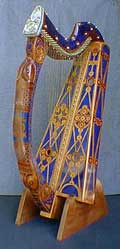
Ancient Irish/Celtic
The frame harp, or a harp that included a straight forepillar (or column in the modern sense), first appeared in Medieval Western Europe in the 8th to 10th centuries AD. Although there are very few remaining in existence, art from that time indicates they utilized about ten or eleven strings. The first harp to feature a hollowed soundbox that amplified the instrument's sound dates back to Ireland in the 14th century. It also included a curved forepillar, a stronger neck and 30 to 36 brass strings.
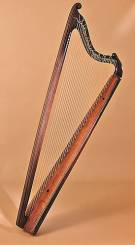
Diatonic Harp
Harps in continental Europe differed from Irish harps in that the forepillar was thinner and less curved, the neck was more slender and it curved upward to meet the end of the column. Referred to as Renaissance harps, they typically had 24 or more gut strings which were fixed to the soundboard with brays (wooden pegs). By the end of the 17th century, they typically had staved sound bodies and straight forepillars.
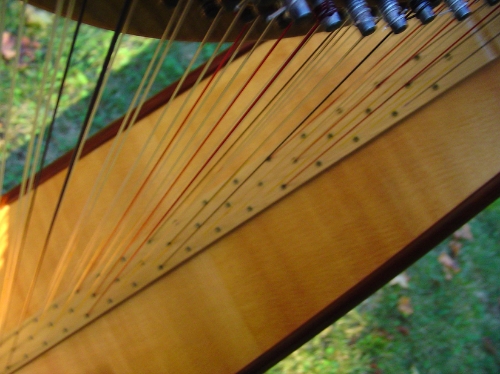
Triple-strung harps
Triple-strung harps first appeared in Italy in the late 16th or early 17th century. They followed the invention of the double-strung harp, which had two rows of strings strategically tuned for use of two-handed playing; by passing a finger between two strings a harpist could reach the corresponding chromatic note in the other row. The triple-strung harp had three rows of strings, the two outer rows were tuned to the same diatonic scale while the inner row was tuned to the outer rows’ chromatic semitones. Two major benefits were that tunes with more rapidly repeated notes could more easily be played and that the doubled, or amplified, rows of the same notes increased the resonance of the instrument.
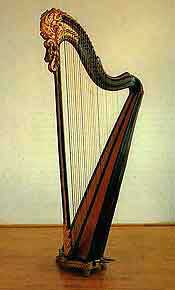
Single-action Pedal
Approximately 1720, a less cumbersome way to get some chromatic notes from a single-strung harp tuned diatonically was introduced. Five pedals (eventually seven) were housed in the bottom of the soundbox. When depressed they connected to hooks that would sharpen the strings of the same note via linkages that passed through the column. The hooks were quickly improved to crochets, which were right-angled rather than u-shaped hooks, then to bequilles, sets of two small levers in which each string wrapped through; when a pedal was depressed, one lever would turn clockwise and the other counter-clockwise, providing a firmer grip. While a better system, they were prone to breakage and produced a buzzing noise.
Near the end of the 18th century, the single-action pedal harp was greatly improved. A model was introduced that had a soundbox built with a separate pine soundboard and a body that was reinforced with internal ribs. Brass action plates were attached to the outside of the harp neck, rather than inside providing strength to the linkage system. The most important improvement was the disc system. Two brass prongs (or forks) extended from a disc that a string passed through before attaching to the tuning peg. When the corresponding pedal was depressed, the discs turned and the strings sharpened a semitone, held firmly against the prong.
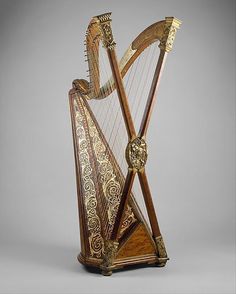
Chromatic / cross-strung
This unique version of the harp was introduced about 1800. It had two necks, two bodies and two columns that crossed in the middle, each double-strung with 40 strings. A simplified version was made in the late 19th century with one body, column and a wider neck which two sets of strings descended, crossed and attached to the soundboard. This version was large and physically difficult to play and virtually abandoned by the mid 1950's.
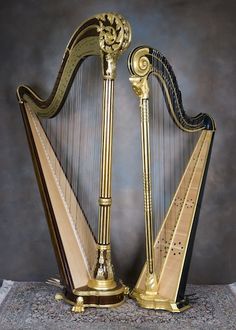
Double-action pedal
The only drawback to the single-action harp was that not every key could be achieved for playing. In 1810, a double-action pedal harp was patented in which the seven pedals could be depressed twice and each string passed through two pronged discs instead of just one. When a pedal was depressed into the first notch, the upper disc turned partially and firmly held the string so that it sharpened a semitone while the bottom disc turned partially but did not touch the string. To sharpen another semitone, the pedal was depressed again into a lower notch and the bottom disc turned further to grip the string even more. Aside from mechanical improvements, this system is still used today.
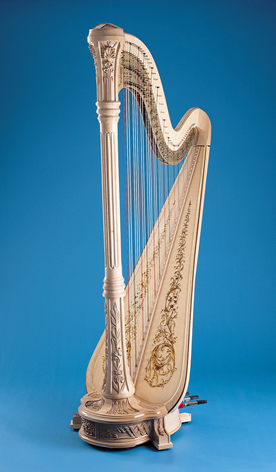
Modern Concert-Grand
Modern harps, like this special-edition "Prince William: Concert Grand," have 47 strings and weigh around 83 pounds. They're about 74.25 inches tall and can range from ~$20,000 to $$189,000. The price range can vary dramatically upon the inclusion of mother-of-pearl, gold leaf, hand carving, rarity, and maker.
Most new orchestral harps average around $24,000 - 34,000 and have a life span of 40+ years if cared for.

New Innovations
Heartland Harps, based in North Carolina, has begun to manufacture carbon-fiber harps (both lever and pedal). Their lever harps tend to average around 8-11 pounds and cost $7,000-8,000.
Experimentation with materials in harps for the frames, mechanisms, and strings are happening every day!









